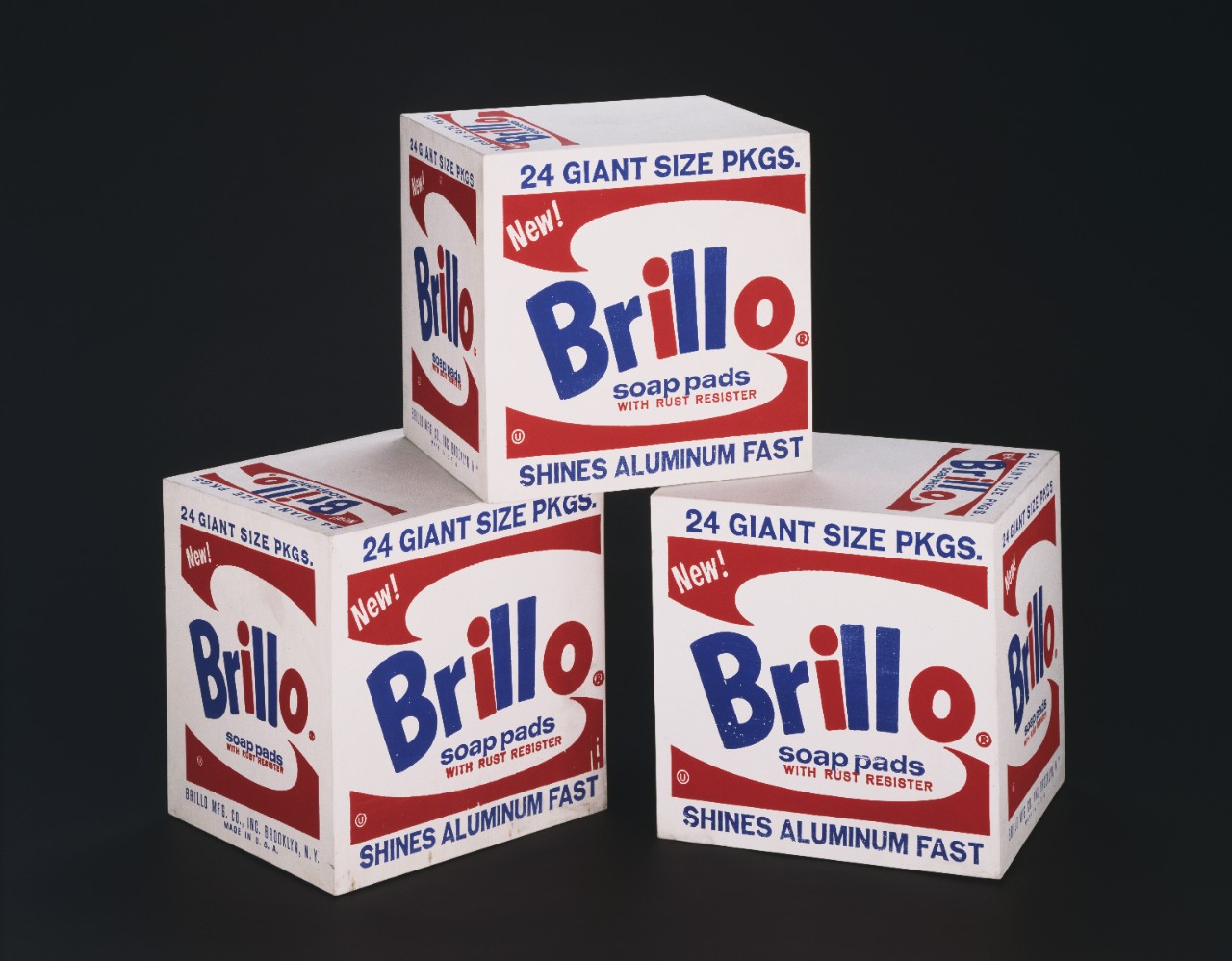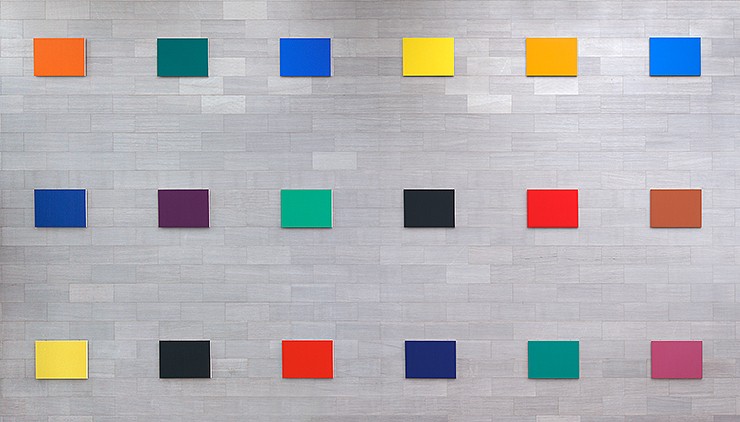Claes Oldenburg, Gemini G.E.L., Profiterole, 1990, cast aluminum, hand-painted by artist, National Gallery of Art, Washington, Gift of Gemini G.E.L. and the Artist, in Honor of the 50th Anniversary of the National Gallery of Art, 1990.104.17
What Is Art?
Grade Level: 9–12 Curriculum Connections: Language Arts
Students will discuss opinions on criteria for what makes a work of art and then debate whether Andy Warhol’s Brillo Boxes can be considered art. Then, students will use everyday objects from their homes as the basis for a new work of art.
Discussion
Present the images of the following works of art from the 20th century and discuss as a class: If you could only choose one, which of these would you use to define the word art? Why?
Ellsworth Kelly, Color Panels for a Large Wall, 1978, oil on canvas, National Gallery of Art, Washington, Purchased with funds provided by The Glenstone Foundation, Mitchell P. Rales, Founder, 2005.87.1
Nam June Paik, Ommah, 2005, one-channel video installation on 19-inch LCD monitor, silk robe, National Gallery of Art, Washington, Gift of the Collectors Committee, 2010.62.1
Willem de Kooning, Woman with a Hat, 1966, oil on paper, National Gallery of Art, Washington, Gift of General Dillman Atkinson Rash in memory of Nancy Phillips Batson Rash and in Honor of the 50th Anniversary of the National Gallery of Art, 1991.94.1
Eugène Atget, A la Grappe d’Or, 4 place d’Aligre, 1911, albumen print, National Gallery of Art, Washington, Patrons’ Permanent Fund, 2002.73.11
Background
Andy Warhol was born Andrew Warhola in Pittsburgh to an immigrant family from central Europe. After studying at the Carnegie Institute of Technology between 1946 and 1949, he moved to New York and quickly achieved success as a commercial artist and illustrator.
Warhol’s first paintings of the 1950s were based on comic strips and advertisements, placing them at the forefront of the rising pop art movement. In pop art, artists found inspiration in the world around them, using references to imagery and products from popular culture and the advertising that was becoming ubiquitous through television, film, and magazines.
Warhol once said that he wanted to “be a machine,” and his concern for eliminating conventional signs of the artist is clear from his shift to techniques such as the use of stencils, rubber stamps, and a photomechanical silkscreen process.
The mechanical means of Warhol’s production called into question the role of the artist in making art. Warhol himself joked in 1963 that he thought someone else should be able to do all his paintings for him. In fact, assistants at the Factory, Warhol’s studio, did help to produce many of them. Moreover, the serial multiplication of Warhol’s images—most famously, his soup cans and Coke bottles—challenged traditional ideas about art’s uniqueness.

Philadelphia Museum of Art, Acquired with funds contributed by the Committee on Twentieth-Century Art and as a partial gift of the Andy Warhol Foundation for the Visual Arts, Inc., 1994-79-1—3, © 2017 The Andy Warhol Foundation for the Visual Arts, Inc. / Artists Rights Society (ARS), New York
Andy Warhol, Brillo Boxes, 1964, screenprint and ink on wood, Philadelphia Museum of Art, Acquired with funds contributed by the Committee on Twentieth-Century Art and as a partial gift of the Andy Warhol Foundation for the Visual Arts, Inc., 1994-79-1–3, © 2017 The Andy Warhol Foundation for the Visual Arts, Inc. / Artists Rights Society (ARS), New York
Activity
In the 1960s customs agents in Canada seized Andy Warhol’s Brillo Boxes, insisting that it was subject to normal duties applied to the cleaning product. They refused to recognize it as a work of art that was constructed to mimic a commercially available product. Divide the class into two teams, one assigned to each side of this dispute. They should prepare their arguments to justify the position that Brillo Boxes either is or is not art. They may want to consider the following questions:
- Does it reflect artistic skill?
- Would you say that the artist used his imagination in creating the work?
- Do you believe the work expresses an idea?
- Do you find it interesting? Beautiful?
Following the class debate, have students bring in everyday objects from their homes and work on a project to make their objects the basis for a work of art for a school exhibition. Students can consider whether they want to add to or alter their objects in any way, what idea they wish to express through the work, and whether the title will impact how it is viewed. Have students leave written comments on their peers’ work in the early stages of creation, and then have students continue to build and revise their works, reflecting on what peers commented on.
Extension
We live in a designed world. Have students explore around school or their homes to find examples of objects that show some level of design—for instance, functional design, graphic design, or fashion design. Do we refer to the designers of these objects as artists? If yes, what makes their work art? If no, why not, and should that change? What makes an artist? Students might be guided in their thinking by reading excerpts from philosopher Arthur C. Danto’s After the End of Art.
National Core Arts Standards
VA:Cn10.1.HSIII Synthesize knowledge of social, cultural, historical, and personal life with art-making approaches to create meaningful works of art or design
VA:Cn11.1.HSI Describe how knowledge of culture, traditions, and history may influence personal responses to art
VA:Cr1.2.HSII Choose from a range of materials and methods of traditional and contemporary artistic practices to plan works of art and design
VA:Pr6.1.HSII Make, explain, and justify connections between artists or artwork and social, cultural, and political history
Play the NGAKids Paintbox interactive
Download or borrow the Art Since 1950 teaching packet
Explore Warhol’s artworks at the National Gallery of Art
Play the NGAKids Photo Op interactive
Register for evening and weekend teacher professional development workshops and apply to participate in the summer teacher institute










